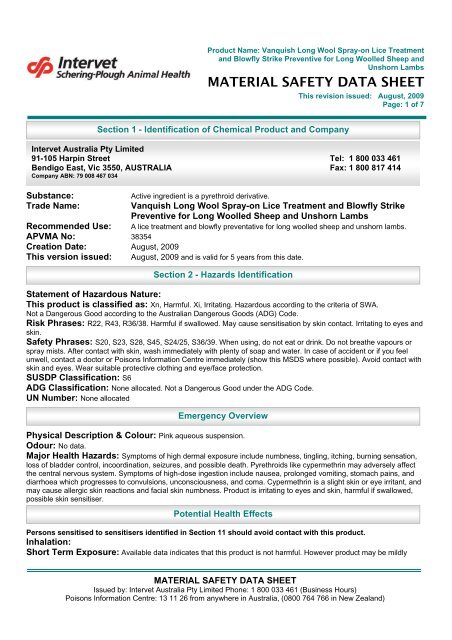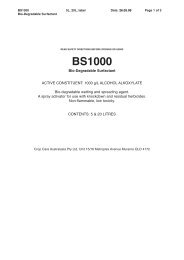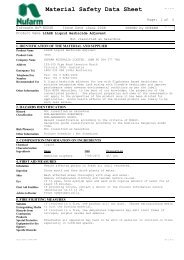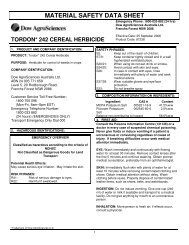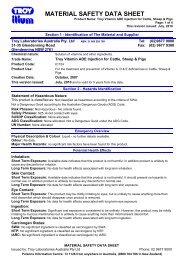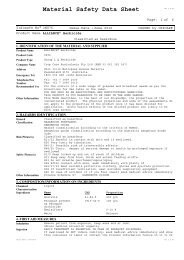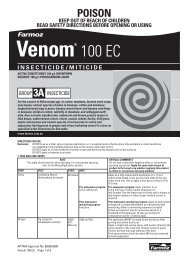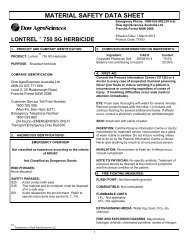995028 Vanquish.MSDS - Agsure
995028 Vanquish.MSDS - Agsure
995028 Vanquish.MSDS - Agsure
- No tags were found...
You also want an ePaper? Increase the reach of your titles
YUMPU automatically turns print PDFs into web optimized ePapers that Google loves.
Product Name: <strong>Vanquish</strong> Long Wool Spray-on Lice Treatmentand Blowfly Strike Preventive for Long Woolled Sheep andUnshorn LambsMATERIAL SAFETY DATA SHEETThis revision issued: August, 2009Page: 1 of 7Section 1 - Identification of Chemical Product and CompanyIntervet Australia Pty Limited91-105 Harpin Street Tel: 1 800 033 461Bendigo East, Vic 3550, AUSTRALIA Fax: 1 800 817 414Company ABN: 79 008 467 034Substance:Active ingredient is a pyrethroid derivative.Trade Name:<strong>Vanquish</strong> Long Wool Spray-on Lice Treatment and Blowfly StrikePreventive for Long Woolled Sheep and Unshorn LambsRecommended Use: A lice treatment and blowfly preventative for long woolled sheep and unshorn lambs.APVMA No: 38354Creation Date: August, 2009This version issued: August, 2009 and is valid for 5 years from this date.Section 2 - Hazards IdentificationStatement of Hazardous Nature:This product is classified as: Xn, Harmful. Xi, Irritating. Hazardous according to the criteria of SWA.Not a Dangerous Good according to the Australian Dangerous Goods (ADG) Code.Risk Phrases: R22, R43, R36/38. Harmful if swallowed. May cause sensitisation by skin contact. Irritating to eyes andskin.Safety Phrases: S20, S23, S28, S45, S24/25, S36/39. When using, do not eat or drink. Do not breathe vapours orspray mists. After contact with skin, wash immediately with plenty of soap and water. In case of accident or if you feelunwell, contact a doctor or Poisons Information Centre immediately (show this <strong>MSDS</strong> where possible). Avoid contact withskin and eyes. Wear suitable protective clothing and eye/face protection.SUSDP Classification: S6ADG Classification: None allocated. Not a Dangerous Good under the ADG Code.UN Number: None allocatedEmergency OverviewPhysical Description & Colour: Pink aqueous suspension.Odour: No data.Major Health Hazards: Symptoms of high dermal exposure include numbness, tingling, itching, burning sensation,loss of bladder control, incoordination, seizures, and possible death. Pyrethroids like cypermethrin may adversely affectthe central nervous system. Symptoms of high-dose ingestion include nausea, prolonged vomiting, stomach pains, anddiarrhoea which progresses to convulsions, unconsciousness, and coma. Cypermethrin is a slight skin or eye irritant, andmay cause allergic skin reactions and facial skin numbness. Product is irritating to eyes and skin, harmful if swallowed,possible skin sensitiser.Potential Health EffectsPersons sensitised to sensitisers identified in Section 11 should avoid contact with this product.Inhalation:Short Term Exposure: Available data indicates that this product is not harmful. However product may be mildlyMATERIAL SAFETY DATA SHEETIssued by: Intervet Australia Pty Limited Phone: 1 800 033 461 (Business Hours)Poisons Information Centre: 13 11 26 from anywhere in Australia, (0800 764 766 in New Zealand)
Product Name: <strong>Vanquish</strong> Long Wool Spray-on Lice Treatmentand Blowfly Strike Preventive for Long Woolled Sheep andUnshorn LambsMATERIAL SAFETY DATA SHEETThis revision issued: August, 2009Page: 4 of 7Storage: This product is a Scheduled Poison. Observe all relevant regulations regarding sale, transport and storage ofthis schedule of poison. Protect this product from light. Store in the closed original container in a dry, cool, well-ventilatedarea out of direct sunlight. Make sure that the product does not come into contact with substances listed under"Incompatibilities" in Section 10. Some liquid preparations settle or separate on standing and may require stirring beforeuse. Check packaging - there may be further storage instructions on the label.Section 8 - Exposure Controls and Personal ProtectionThe following Australian Standards will provide general advice regarding safety clothing and equipment:Respiratory equipment: AS/NZS 1715, Protective Gloves: AS 2161, Industrial Clothing: AS2919, Industrial EyeProtection: AS1336 and AS/NZS 1337, Occupational Protective Footwear: AS/NZS2210.SWA Exposure Limits TWA (mg/m 3 ) STEL (mg/m 3 )Exposure limits have not been established by SWA for any of the significant ingredients in this product.The ADI for Alpha Cypermethrin is set at 0.05mg/kg/day. The corresponding NOEL is set at 5mg/kg/day. ADI meansAcceptable Daily Intake; NOEL means No-observable-effect-level. Taken from Australian ADI List, Dec 2008.No special equipment is usually needed when occasionally handling small quantities. The following instructions are forbulk handling or where regular exposure in an occupational setting occurs without proper containment systems.Ventilation: This product should only be used in a well ventilated area. If natural ventilation is inadequate, use of a fanis suggested.Eye Protection: Protective glasses or goggles should be worn when this product is being used. Failure to protect youreyes may cause them harm. Emergency eye wash facilities are also recommended in an area close to where this productis being used.Skin Protection: If you believe you may have a sensitisation to this product or any of its declared ingredients, youshould prevent skin contact by wearing impervious gloves, clothes and, preferably, apron. Make sure that all skin areasare covered. See below for suitable material types.Protective Material Types: We suggest that protective clothing be made from the following materials: butyl rubber.Respirator: Usually, no respirator is necessary when using this product. However, if you have any doubts consult theAustralian Standard mentioned above. Otherwise, not normally necessary.Eyebaths or eyewash stations and safety deluge showers should be provided near to where this product is being used.Section 9 - Physical and Chemical PropertiesPhysical Description & Colour: Pink aqueous suspension.Odour:No data.Boiling Point:Approximately 100°C at 100kPa.Freezing/Melting Point:Approximately 0°C.Volatiles:Water component.Vapour Pressure:2.37 kPa at 20°C (water vapour pressure).Vapour Density:No data.Specific Gravity: 1.015 at 20°CWater Solubility:Completely soluble in water.pH:No data.Volatility:No data.Odour Threshold:No data.Evaporation Rate:No data.Coeff Oil/water Distribution: No dataAutoignition temp:Does not burn.MATERIAL SAFETY DATA SHEETIssued by: Intervet Australia Pty Limited Phone: 1 800 033 461 (Business Hours)Poisons Information Centre: 13 11 26 from anywhere in Australia, (0800 764 766 in New Zealand)
Product Name: <strong>Vanquish</strong> Long Wool Spray-on Lice Treatmentand Blowfly Strike Preventive for Long Woolled Sheep andUnshorn LambsMATERIAL SAFETY DATA SHEETThis revision issued: August, 2009Page: 5 of 7Section 10 - Stability and ReactivityReactivity: This product is unlikely to react or decompose under normal storage conditions. However, if you have anydoubts, contact the supplier for advice on shelf life properties.Conditions to Avoid: Protect this product from light. Store in the closed original container in a dry, cool, wellventilatedarea out of direct sunlight.Incompatibilities: strong acids, strong bases, strong oxidising agents.Fire Decomposition: Only small quantities of decomposition products are expected from this products attemperatures normally achieved in a fire. This will only occur after heating to dryness. Carbon dioxide, and if combustionis incomplete, carbon monoxide and smoke. Water. Carbon monoxide poisoning produces headache, weakness, nausea,dizziness, confusion, dimness of vision, disturbance of judgment, and unconsciousness followed by coma and death.Polymerisation: This product will not undergo polymerisation reactions.Section 11 - Toxicological InformationToxicity: An information profile for Cypermethrin is available at http://extoxnet.orst.edu/pips/ghindex.htmlAcute toxicity: Cypermethrin is a harmful material by dermal absorption or ingestion. The oral LD50 for cypermethrin inrats is 250 mg/kg (in corn oil) or 4123 mg/kg (in water). The oral LD50 varies from 367 to 2000 mg/kg in female rats, andfrom 82 to 779 mg/kg in mice, depending on the ratio of cis/trans- isomers present. This wide variation in toxicity mayreflect different mixtures of isomers in the materials tested. The dermal LD50 in rats is 1600 mg/kg and in rabbits isgreater than 2000 mg/kg.Chronic toxicity: Not AvailableReproductive effects: No adverse effects on reproduction were observed in a three-generation study with rats givendoses of 37.5 mg/kg/day, the highest dose tested.Teratogenic effects: Cypermethrin is not teratogenic. No birth defects were observed in the offspring of rats given dosesas high as 70 mg/kg/day nor in the offspring of rabbits given doses as high as 30 mg/kg/day.Mutagenic effects: Cypermethrin is not mutagenic, but tests with very high doses on mice caused a temporary increasein the number of bone marrow cells with micronuclei. Other tests for mutagenic effects in human, bacterial, and hamstercell cultures and in live mice have been negative.Carcinogenic effects: EPA has classified cypermethrin as a possible human carcinogen because available informationis inconclusive. It caused benign lung tumors in female mice at the highest dose tested (229 mg/kg/day); however, notumors occurred in rats given high doses of up to 75 mg/kg/day.Organ toxicity: Pyrethroids like cypermethrin may cause adverse effects on the central nervous system. Rats fed highdoses (37.5 mg/kg) of the cis-isomer of cypermethrin for five weeks exhibited severe motor incoordination, while 20 to30% of rats fed 85 mg/kg died 4 to 17 days after treatment began. Long-term feeding studies have shown increased liverand kidney weights and adverse changes in liver tissues in test animals. Pathological changes in the cortex of thethymus, liver, adrenal glands, lungs, and skin were observed in rabbits repeatedly fed high doses of cypermethrin.Fate in humans and animals: In humans, urinary excretion of cypermethrin metabolites was complete 48 hours after thelast of five doses of 1.5 mg/kg/day. Studies in rats have shown that cypermethrin is rapidly metabolized by hydroxylationand cleavage, with over 99% being eliminated within hours. The remaining 1% becomes stored in body fat. This portion iseliminated slowly, with a half-life of 18 days for the cis-isomer and 3.4 days for the trans-isomer. There is no data tohand indicating any particular target organs.Alpha Cypermethrin is Classed by SWA as a potential sensitiser by skin contact.Classification of Hazardous IngredientsIngredientAlpha CypermethrinRisk Phrases>=1%Conc
Product Name: <strong>Vanquish</strong> Long Wool Spray-on Lice Treatmentand Blowfly Strike Preventive for Long Woolled Sheep andUnshorn LambsMATERIAL SAFETY DATA SHEETThis revision issued: August, 2009Page: 6 of 7This product is biodegradable. It will not accumulate in the soil or water or cause long term problems.Effects on birds: Cypermethrin is practically non-toxic to birds. No adverse reproductive effects occurred in mallards orbobwhite quail given 50 ppm, the highest dose tested.Effects on aquatic organisms: Cypermethrin is very highly toxic to fish and aquatic invertebrates. Cypermethrin ismetabolized and eliminated significantly more slowly by fish than by mammals or birds, which may explain thiscompound's higher toxicity in fish compared to other organisms. The half-lives for elimination of several pyrethroids bytrout are all greater than 48 hours, while elimination half-lives in birds and mammals range from 6 to 12 hours. Thebioconcentration factor for cypermethrin in rainbow trout was 1200 times the ambient water concentration, indicating thatthere is a moderate potential to accumulate in aquatic organisms. Elimination of half of the accumulated amount of thecompound took nearly eight days.Effects on other organisms: Cypermethrin is highly toxic to bees.Environmental Fate:Breakdown in soil and groundwater: Cypermethrin has a moderate persistence in soils. Under laboratory conditions,cypermethrin degrades more rapidly on sandy clay and sandy loam soils than on clay soils, and more rapidly in soils lowin organic material. In aerobic conditions, its soil half-life is 4 days to 8 weeks. Cypermethrin is not soluble in water andhas a strong tendency to adsorb to soil particles. It is therefore unlikely to cause groundwater contamination.Breakdown in water: In neutral or acid aqueous solution, cypermethrin hydrolyzes slowly, with hydrolysis being morerapid at pH 9 (basic solution). Under normal environmental temperatures and pH, cypermethrin is stable to hydrolysis witha half-life of greater than 50 days and to photodegradation with a half-life of greater than 100 days. In pond waters and inlaboratory degradation studies, pyrethroid concentrations decrease rapidly due to sorption to sediment, suspendedparticles and plants. Microbial degradation and photodegradation also occur.Breakdown in vegetation: When applied to strawberry plants, 40% of the applied cypermethrin remained after one day,12% remained after three days, and 0.5% remained after seven days, with a light rain occurring on day 3. Whencypermethrin was applied to wheat, residues on the wheat were 4 ppm immediately after spraying and declined to 0.2ppm 27 days later. No cypermethrin was detected in the grain.Disposal: This product may be recycled if unused, or if it has not been contaminated so as to make it unsuitable for itsintended use. If it has been contaminated, it may be possible to separate the contamination in some way. Only if neitherof these options is suitable, consider landfill.ADG Code: This product is not classified as a Dangerous Good. No special transport conditions are necessary unlessrequired by other regulations.AICS: All of the significant ingredients in this formulation are compliant with NICNAS regulations.The following ingredient: Alpha cypermethrin is mentioned in the SUSDP.This <strong>MSDS</strong> contains only safety-related information. For other data see product literature.Acronyms:ADG CodeAICSSWASection 12 - Ecological InformationSection 13 - Disposal ConsiderationsSection 14 - Transport InformationSection 15 - Regulatory InformationSection 16 - Other InformationAustralian Code for the Transport of Dangerous Goods by Road and Rail (7 th edition)Australian Inventory of Chemical SubstancesSafe Work Australia, formerly ASCC and NOHSCMATERIAL SAFETY DATA SHEETIssued by: Intervet Australia Pty Limited Phone: 1 800 033 461 (Business Hours)Poisons Information Centre: 13 11 26 from anywhere in Australia, (0800 764 766 in New Zealand)
CAS numberHazchem CodeIARCNOSNTPR-PhraseSUSDPUN NumberProduct Name: <strong>Vanquish</strong> Long Wool Spray-on Lice Treatmentand Blowfly Strike Preventive for Long Woolled Sheep andUnshorn LambsMATERIAL SAFETY DATA SHEETThis revision issued: August, 2009Page: 7 of 7Chemical Abstracts Service Registry NumberEmergency action code of numbers and letters that provide information to emergencyservices especially firefightersInternational Agency for Research on CancerNot otherwise specifiedNational Toxicology Program (USA)Risk PhraseStandard for the Uniform Scheduling of Drugs & PoisonsUnited Nations NumberTHIS <strong>MSDS</strong> SUMMARISES OUR BEST KNOWLEDGE OF THE HEALTH AND SAFETY HAZARD INFORMATION OF THE PRODUCT AND HOW TOSAFELY HANDLE AND USE THE PRODUCT IN THE WORKPLACE. EACH USER MUST REVIEW THIS <strong>MSDS</strong> IN THE CONTEXT OF HOW THEPRODUCT WILL BE HANDLED AND USED IN THE WORKPLACE.IF CLARIFICATION OR FURTHER INFORMATION IS NEEDED TO ENSURE THAT AN APPROPRIATE RISK ASSESSMENT CAN BE MADE, THEUSER SHOULD CONTACT THIS COMPANY SO WE CAN ATTEMPT TO OBTAIN ADDITIONAL INFORMATION FROM OUR SUPPLIERSOUR RESPONSIBILITY FOR PRODUCTS SOLD IS SUBJECT TO OUR STANDARD TERMS AND CONDITIONS, A COPY OF WHICH IS SENT TOOUR CUSTOMERS AND IS ALSO AVAILABLE ON REQUEST.Please read all labels carefully before using product.This <strong>MSDS</strong> is prepared in accord with the SWA document “National Code of Practice for thePreparation of Material Safety Data Sheets” 2nd Edition [NOHSC:2001(2003)]MATERIAL SAFETY DATA SHEETIssued by: Intervet Australia Pty Limited Phone: 1 800 033 461 (Business Hours)Poisons Information Centre: 13 11 26 from anywhere in Australia, (0800 764 766 in New Zealand)


